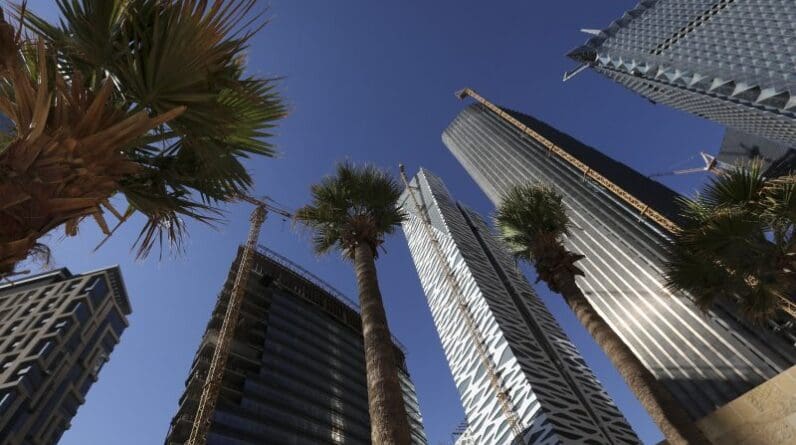
This article was written by Christine Burke. It appeared first on the Bloomberg Terminal.
Saudi Arabia’s banks could raise a record amount of debt this year as a liquidity squeeze strains Crown Prince Mohammed bin Salman’s multi-trillion dollar economic transformation agenda.
Lenders may need to issue at least $11.5 billion in bonds in local and foreign currencies, according to Bloomberg Intelligence, to raise funds for Vision 2030, a plan aimed at transforming Saudi Arabia from an oil-reliant economy to one generating income from everything from tourism to technology. That would be a new high, surpassing the $10 billion raised in 2022.
The sheer size of the required investment, coupled with slower deposit growth at the kingdom’s banks and a lack of foreign investment into Saudi Arabia, means lenders will need to lean heavily on borrowing to come up with funds for mega projects such as urban development Neom and entertainment city Qiddiya, according to Riyadh-based Jadwa Investment Co.
“The one issue which I think is the most troubling for the whole Vision 2030 project is the lack of capital,” said James Reeve, the former chief economist at Jadwa who has since been hired by Saudi Arabia’s sovereign wealth fund. “The Saudi banking system is kind of tapped out.”
Saudi Arabia’s lenders have been grappling with tighter liquidity as loan growth has outstripped deposits to support a domestic economy that contracted last year. The country will require $640 billion in construction spending over the next five years based on the current pipeline of projects, according to data compiled by Dubai-based analysis firm MEED Projects. That suggests banks may need to come up with almost $384 billion over that period if they fund 60% of the pipeline, using a mix of more deposits and debt.
Saudi Arabian deposit growth remains the key driver of funding, but some 15% of what’s needed may need to come from debt, according to Edmond Christou, senior financials analyst for Bloomberg Intelligence. That would translate into new issuance of at least around $11.5 billion a year.
“Banks don’t have the liquidity to support the size of construction needs but they will be gathering more deposits and tapping into the international debt market,” said Dubai-based Christou.
Debt issuance is already showing signs of acceleration. About $6.8 billion has been sold this year so far, according to Bloomberg Intelligence. That compares with $5.4 billion issued by local lenders for the whole of last year.
Despite the ambitious funding requirement, Saudi Arabia’s bank balance sheets are still viewed as healthy. S&P Global Ratings rates most key lenders at investment grade with a stable outlook and said they won’t be able to carry the full spending burden for Vision 2030.
Projects are also heavily financed by the central government and related entities. The deep-pocketed Public Investment Fund has said it aims to deploy capital of $70 billion a year after 2025, and is weighing up fundraising plans of its own.
There are also signs the 2030 deadline may slip. Saudi Arabia Finance Minister Mohammed Al Jadaan said in December some unspecified projects may be delayed as more time may be needed to build up factory and workforce capacity.
Amwal Capital Partners expects the government, alongside state companies and other entities, to issue their own bonds. That includes another $3 billion from the PIF, said Zeina Rizk, partner and co-head of fixed income at the Dubai-based firm.
Successful bank and government offerings may help offset lackluster oil prices, which are creating a hole in state finances. Saudi Arabia’s oil export revenues sank by almost $80 billion to $248 billion last year, a slump that pulled the budget back into a deficit and offered a reminder of the country’s dependence on high energy prices.
Fitch said last month that Saudi Arabia needs crude to trade above $90 a barrel this year to balance its budget, higher than Brent’s current level of around $85. If counting domestic spending by the kingdom’s wealth fund, the kingdom requires oil at $108, according to Bloomberg Economics.
Liquidity improving
There are signs that liquidity has improved since the start of the year, suggesting banks may have a bit of wiggle room before needing to tap fixed-income markets. A key gauge of borrowing costs in Saudi Arabia, known as Saibor, has retreated since spiking to almost 6.4% in January, though is still well above 6% amid elevated interest rates in the US.
Central bank deposits at Saudi lenders climbed in January and the ratio of statutory net loans to deposits — the measure the kingdom’s reserve bank closely monitors — dropped to 80.1% after averaging above 80.5% in 2023, indicating more coverage of outstanding credit.
“It’s important to remember that the scale of financing required is substantial,” said Samer Jumean, partner and head of infrastructure at KPMG in Saudi Arabia. “Liquidity isn’t going to dry up but it’s the right thing to do to start tapping the capital markets.”







